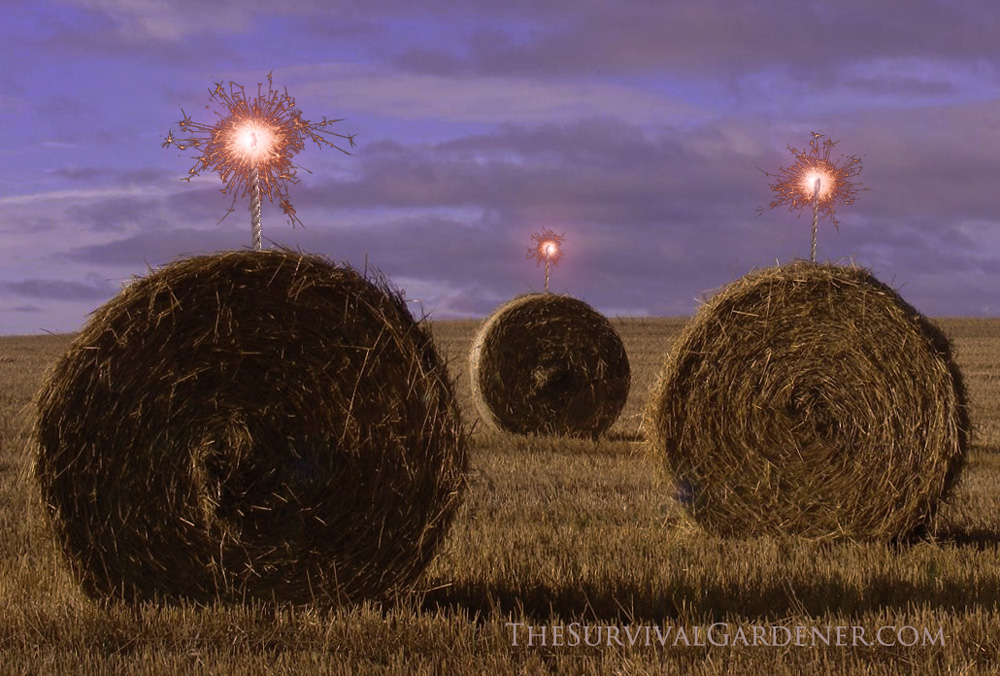On my controversial article on straw bale gardening, I recently received this comment from Terri of Ladybug Farms:
“I totally concur! I became the first certified organic hay supplier in Georgia in 2015. A lot of people said “why bother”. I wasn’t sure myself but I knew I had really clean hay, I wanted to encourage small herd ruminants to get certified, I wanted to support Georgia Organics 100 Organic Farms campaign and it just felt like the right thing to do. It took me a year or so of schlepping around these heavy hay bales as I searched for customers. I kept hearing stories of peoples gardens getting wiped out – poor seed germination, stunted plants, etc. The common thread was they got horse manure from a neighbor down the way. Hmmmm. Slowly I started to put it together as stories such as these began to surface. I only produce 200 square bales a year on my 7 acres and could sell 5 times the amount of hay if I had it. I hope others will pursue organic certification as there is a large demand. Thanks for posting this article!”
But, that’s not all. Over at my reprinting of the article at The Grow Network, I received this comment yesterday:
“I am a market farmer who lost 1200 potted tomato and pepper seedlings one year due to using worm castings (in my soil mix) that had clopyralid contamination (as I found out later from the local Extension Horticulturist). The person who made the worm castings had used a new source of barley straw for the worms. The clopyralid went through the digestive tract of the worms and was still intact. Apparently, clopyralid (and similar herbicides) can be active for years. I now test my worm castings before using by planting tomato seeds with it. If they grow normally after 3-4 weeks I know there is no contamination. I have since talked with many people who have had terrible herbicide problems from using straw as mulch for their home gardens. The local farmers often do not read the label fully or understand the problems, and sometimes aren’t even aware that their straw has been sprayed with clopyralid.”
People don’t get it. This stuff is wicked. And Joel Karsten attacks those who mention the potential for problems.
Look – I’ve even filmed the issue:
And I’m not alone. Karen Land has shared her story here.
Watch your back.


5 comments
I read that article you wrote on Joel Karsten’s criticism before, and something jumped out at me that I didn’t mention at the time.
When pointing out how “safe” glyphosate is, he cites two studies which he uses to claim that it is less toxic than coffee. The problem for Joel is that the studies were for toxicity in humans (via rats), not in plants. You were talking about how bad it was for the gardens because of its persistent toxic effect on plants, and he totally whiffed on that in trying to prove that it’s OK for people. This strikes me as one of those scan-until-offended situations, where he keyed on the word “toxic” and went off down the wrong road from there.
But it’s really difficult to ingest glyphosate in the first place if the plants don’t live to produce anything. Well, without actually eating the straw (or manure), I guess….
I mean, how hard is it to understand that a product designed to kill plants, actually kills plants?
Yeah, Karsten’s livelihood is tied up in this so I think he’s not exactly even keel, which I understand. He could have responded fairly and I would have interviewed him to talk about the issue – instead, he went nuts, claiming it was clickbait, etc. Which is ironic, because a short time later he was did a puff piece interview on Straw Bale Gardening on the VERY SAME SITE where he’d torn into me.
Question? Using straw in with the chickens to put on the floor of the pen. How does transfer over when cleaning out the pen an putting in compost pile or cover the garden for the winter? How for does the herbicide trickle down? How do I find out if the straw I use has been sprayed with something I don’t want in my garden?
Hi Rebecca. Good question.
Aminopyralid is sprayed on some straw crops and on a lot of hay fields. Those plants take it up without harm, as they can live through it. Then, when they decay, the molecule persists for a long time, and it’s capable of destroying gardens. It’s targeted towards broad-leaf weeds, so it will kill tomatoes, beans, melons, etc., but won’t harm grasses like corn.
I wouldn’t put that straw into a regular compost pile. Make a separate one, since it’s potentially contaminated. Once it breaks down into compost, take compost from multiple places in the pile and put it into a pot, then plant beans in it. If they get past the sprouting stage and are able to open multiple sets of leaves without curling up, it’s safe. Alternately, you can transplant tomatoes or eggplant seedlings into it. They usually start distorting in a couple of weeks.
Hi David, do you think “coastal grasses” could have the problem? The feed store I get stuff from has hay and “coastal grasses”, I was buying it by the bag for my chicken laying boxes, then I got worried about it in the compost and switched to pine wood shavings. The chickens didn’t care and the shavings are easier to clean. Any problems with shavings in the compost? Thanks for easy access to your knowledge and experience.
Comments are closed.